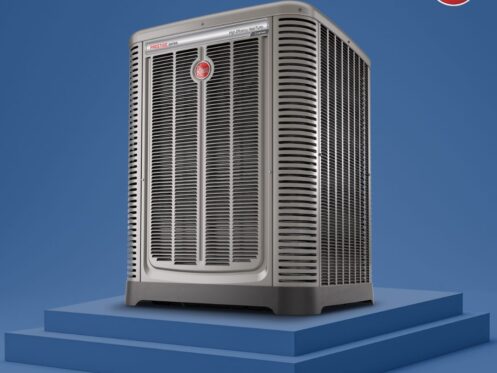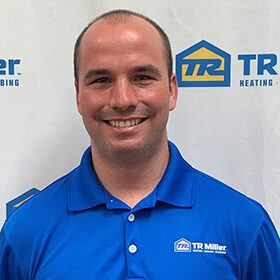Heat pumps are becoming a good alternative to both furnaces and ACs. This is because they can both heat and cool your home. There are several types of heat pumps to choose from, so how do you know which is best for your home? Understanding the different types of heat pumps and how they work in specific environments can help you make an informed decision.
What Is a Heat Pump?
Heat pumps are versatile systems that use a refrigerant to transfer heat into or out of your home, adapting to the season. In the summer, they pump out the hot air inside your home and also dehumidify. In the winter, they pump hot air in from outside. Most heat pumps use electricity to get this process started.
Typically, a heat pump system consists of an outdoor unit and an indoor unit. The outdoor unit absorbs or releases heat from the outside air, while the indoor unit circulates the conditioned air through your home. The refrigerant cycles between liquid and gas states, absorbing and releasing heat through the indoor and outdoor coils. A compressor increases the temperature by pressurizing the refrigerant gas, enhancing the heat exchange process.
Heat pumps are available as either ducted or ductless mini-split systems or full package systems. Mini splits that use your ducts have an indoor evaporative unit and an outdoor compressor unit. Ductless mini splits are perfect for homes that don’t have ductwork. Full packaged systems have both the evaporative and compressor unit together in one box that is outside. In this type of system, only the ductwork is inside your home.
There are many benefits to having a heat pump installed:
- Energy efficiency
- Increased comfort
- Heating and cooling function
- Environmentally friendly operation
- Space-saving design
Different Types of Heat Pumps
Heat pumps provide a versatile and efficient way to heat and cool your home. When searching for a unit, you’ll have options utilizing various energy sources and technologies to keep your space comfortable.
Air-Source Heat Pump
Air-source heat pumps are the most common type found in the United States. Depending on the season, they extract heat from the air outside or in your home. These pumps use existing ductwork to transport the heated air throughout your home.
Thanks to continued technological advancements, heat pumps can now efficiently heat your home at lower temperatures. Most air-source heat pumps can generate sufficient heat down to 5 degrees Fahrenheit and are still partially operational below zero. You might require a backup heating system, like electric heating strips, if you live in a very cold climate.
Water-Source Heat Pump
As the name implies, these heat pumps collect heat from water instead of air. The indoor unit has a fan, air coil, compressor, and water coil. It is connected to a loop full of warm or cold water. To heat your indoor space, it draws cold air in across the air coil, which heats it. This warmed air is then distributed throughout your house. To cool your house, it draws in the warm air from inside and brings it across the air coil to cool it. This cooled air is then distributed back into your home.
These heat pumps can function as either water-to-air systems, which use ductwork to distribute heat, or water-to-water systems, which can heat your home’s water supply, swimming pools, and radiant floor heating systems. Additionally, these heat pumps can be employed for melting snow on walkways and driveways.
Air-to-Water Heat Pump
These heat pumps source heat from the air but then move it to water. They have an outdoor unit and a hydrobox indoor unit. They heat your home’s water and provide radiant heat for your floors, walls, and ceilings. Even at freezing temperatures, these systems function well. If you live in an area where the temperature regularly drops below zero, you may need an additional heating system, such as a wood stove, boiler, or electric-resistant heat.
Ground-Source Heat Pump
These heat pumps, also known as geothermal heat pumps, draw heat from the ground. The temperature underground is constant, so you don’t have to worry about ice or snow. They have a higher upfront cost but require less maintenance than other types of heat pumps.
Ground-source heat pumps feature buried loops that are full of either water or a mix of water and antifreeze to facilitate the transfer of heat either inside or outside. They take heat from the earth and transfer it through the loop to heat your house. It gets heated even further and then distributed throughout your home. To cool your home, it works in reverse by removing the heat from your home and transferring it through the loop into the ground.
Gas Absorption Heat Pump
Gas absorption heat pumps (GAHPs) use water and ammonia to transfer heat in and out of your home. The primary energy source for these systems is natural gas, which can lead to lower electrical bills, especially in areas where gas is more economical than electricity. These systems absorb heat through the evaporation of ammonia and then release it into your home by condensing the ammonia back into a liquid.
GAHPs can be connected to wall units to provide space heating or integrated into radiant floor heating systems. They can also be used to heat water. In addition to their versatility and efficiency, another key feature of gas absorption heat pumps is their ability to operate at very low temperatures. Some units are efficient in temperatures down to -20 Fahrenheit.
Solar Heat Pumps
Both air and geothermal heat pumps can use power from your solar panels. Specifically, these heat pumps use photovoltaic panels to collect solar energy and convert it into electricity. As a result, you can heat and cool your house entirely with renewable energy, saving you even more money on electricity. Of course, solar heat pumps are particularly effective in sunny climates, but they can provide benefits in various areas.
Cold Climate Heat Pump
These heat pumps work similarly to the air-sourced ducted heat pumps. The difference is that they can provide higher heat capacity. They use a variable-speed compressor and inverter to help increase heat capacity. This means that when the temps fall, they can keep up with your heating needs more efficiently. This lessens the need for a backup heating system.
Hybrid Heat Pump
A hybrid heat pump is similar to an air-sourced one, except it also uses a gas furnace to make sure you stay warm on those extra cold winter days. You can pair air or geothermal heat pumps with your gas furnace. When it gets below 40 degrees Fahrenheit, this system automatically switches to your gas furnace.
VRF Systems
Variable refrigerant flow technology uses integrated controls and sensors to cool and heat. They transfer heat between the indoor and outdoor units using conditioned refrigerant. These heat pumps are perfect for zoning. They can work with up to 50 units, making them ideal for commercial use.
Heat Pump Services in Plainfield
TR Miller Heating, Cooling & Plumbing has been providing quality HVAC and plumbing services to Plainfield, IL and surrounding areas for over 15 years. We are family-owned and -operated and treat our customers like family. We pride ourselves on having a strong work ethic and enjoy getting the job done. You can trust us to provide you with excellent service.
Contact TR Miller Heating, Cooling & Plumbing for more information on heat pumps or our other services today!


